Photography courtesy of Lowell Washburn, all rights reserved.
If the sight of the first robin signals the arrival of spring; then what sign would we use to mark the beginning of summer? According to government time keepers, the answer is simple. Summer officially begins with the summer solstice which, in Iowa, will occur on June 20 at 11:24 pm. But although the solstice may be undeniably accurate, some folks choose to go a different [unofficial] route to determine the change of season. For them, the event is something more personal, like the last day of the school year or perhaps the Memorial Day weekend that marks the true beginning of summer. For me, the most reliable cue that summer has really arrived is the sudden appearance of an intricately designed flower known as the prairie blue flag.
The prairie blue flag is one of Iowa’s most colorful wildflowers. Known to science as Iris versicolor the species is, as its name suggests, a member of the iris family. A forerunner of domesticated garden plants, the wild iris is a native inhabitant of low lying prairies and wetland fringes. Most frequently associated with shallow prairie pothole wetlands, the blue flag prefers moist soil and is often found standing alongside cattail beds or river bulrush.
Blue flags come into bloom after most woodland wildflowers have disappeared but before warm season prairie flowers make their appearance. And although blue flags are never as abundant as most of the flowering plants that come before or after, they do attain local importance to wildlife. Wild irises begin blooming in southern Iowa during late May. By early June, the spectacular blue flowers are peaking statewide; achieving their greatest abundance in the heavily glaciated prairie pothole region. Timing is everything and the iris helps to fill what is somewhat of a botanical gap by providing a critical food source at a time when other nectar producers may be comparatively scarce.
Earlier this week, I received a firsthand opportunity to observe the blue flag’s popularity with wildlife. Hoping to photograph wood ducks, I had popped up a ground blind at the water line of a small pond situated between two oak woodlands. Although much of the pond was bordered by dense stands of river bulrush, I had placed my blind in an opening next to a population containing sixty or seventy wild blue flag irises – most in full bloom. Shortly after daybreak, the flower bed began to come alive with a variety of six-legged, winged visitors – some were familiar; others I had to look up. The show was soon dominated, however, by the sudden arrival of nectar seeking ruby throated hummingbirds.
It was probably their first meal of the day, and it quickly became obvious that the birds meant business. Probing deep into the flower’s center, each hummingbird enthusiastically guzzled nectar from six to ten plants before returning to the woodlands. The traffic was nearly constant as new incomers hummed and hovered their way through the flowers’ sword-shaped leaves – many feeding within inches of my position. It soon became apparent that the iris bed was attracting hummingbirds from far and wide. After observing the birds’ aggressive feeding behavior, it became obvious that the ruby-throats were a much more efficient pollinator than any of the visiting insects. It was a great relationship. As payment for life sustaining nectar, the hummingbirds were liberally spreading pollen throughout the iris colony and likely to other nearby stands of blue flags as well.

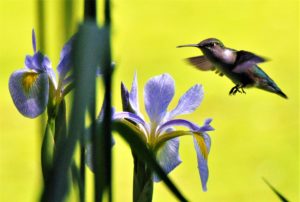
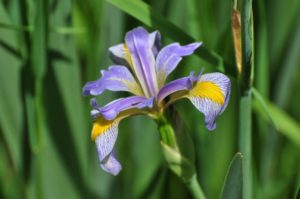
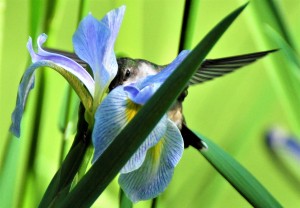
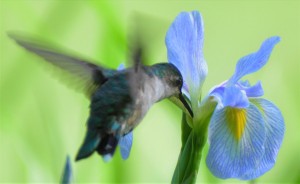
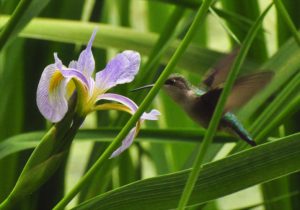

 Tom Cope
Tom Cope Sue Wilkinson
Sue Wilkinson Susan Judkins Josten
Susan Judkins Josten Rudi Roeslein
Rudi Roeslein Elyssa McFarland
Elyssa McFarland Mark Langgin
Mark Langgin Adam Janke
Adam Janke Joe Henry
Joe Henry Kristin Ashenbrenner
Kristin Ashenbrenner Joe Wilkinson
Joe Wilkinson Dr. Tammy Mildenstein
Dr. Tammy Mildenstein Sean McMahon
Sean McMahon